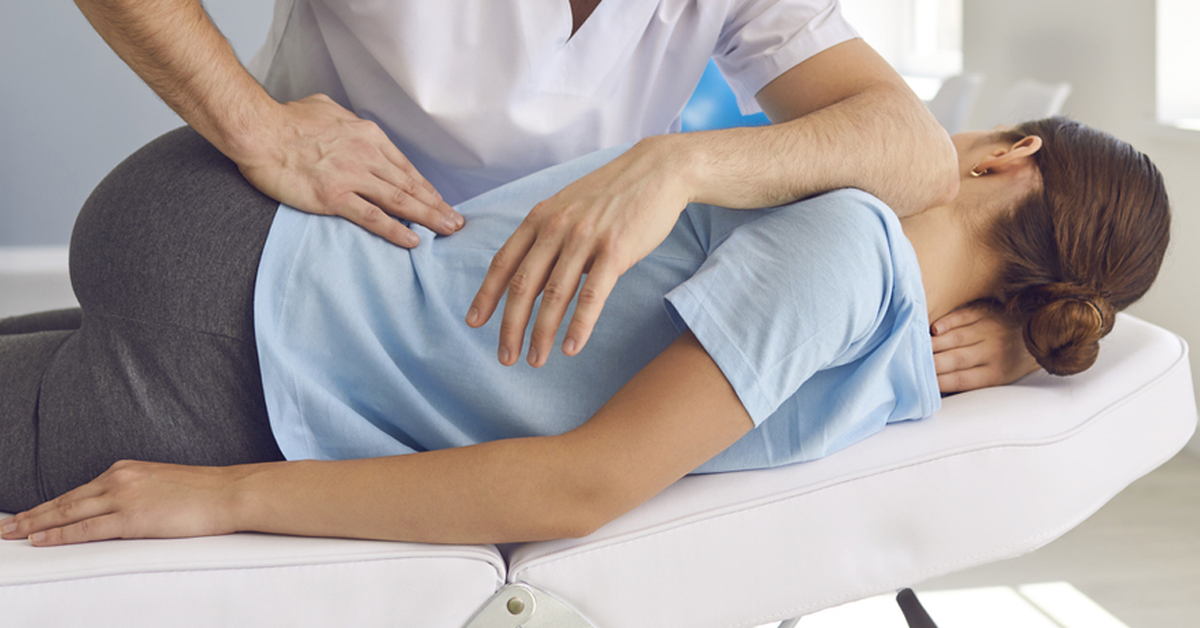
Important Disclaimer: OMM is only available to established patients under the care of a provider who practices OMM. It cannot be scheduled as a separate treatment, consultation, or walk-in service.
Got back pain, muscle tension, or stiff joints? Osteopathic Manipulative Medicine (OMM) might be the relief you’re looking for.
Osteopathic Manipulative Medicine (OMM) is a hands-on treatment that uses gentle pressure and resistance to realign muscles, tissues, joints, and bones—helping the body function and heal naturally.
OMM is a way to use resistance and pressure to adjust your muscles, tissues, joints, and bones back into their proper position, helping your body heal and work the way it should. Osteopathic manipulative treatment is used to correct structural or functional issues within your body; it is non-invasive and doesn’t require medication. Doctors of Osteopathic Medicine (DO), are fully licensed physicians—just like an MD (Doctor of Medicine). DOs go to medical school, can prescribe medicine, do surgery, and treat all kinds of health problems. But they also get extra training in the muscles, bones, and joints—called the musculoskeletal system—and learn how the body’s systems work together. DOs focus on treating the whole person, not just the symptoms, and OMM is one way they help patients.
What Can OMM Help With?
Doctors use OMM to help with many problems, such as:
- Back pain
- Neck pain
- Headaches
- Joint or muscle pain
- Tightness
- Trigger Points: Trigger points are painful, tight, band-shaped nodules in skeletal muscle
Other conditions that OMM can provide relief for could assist with other systems in the body, like swelling during pregnancy, breathing, and bowel issues.
Some people feel better after just one treatment, while others may benefit from a series of treatments. Your doctor will help decide what’s best for you.
Is OMM right for you?
OMM is sometimes incorporated into a patient's overall care plan when appropriate. It is not a separate or stand-alone service. If you’re experiencing discomfort or pain, the first step is to discuss your symptoms with your primary care provider (PCP). They’ll determine whether OMM is suitable for you and, if so, provide guidance on how to connect with the appropriate Doctor of Osteopathic Medicine (DO).
Frequently Asked Questions
Q: Is OMM the same as a massage?
A: No. It may feel relaxing, but OMM is a medical treatment. The doctor looks at how your body moves and functions. After diagnosing the issue, they can use an OMM procedure to help it get back in balance.
Q: Will it hurt?
A: OMM is usually gentle. Most people don’t feel pain during it. You might feel a little sore afterward, similar to when you stretch or experience soreness after exercising.
Q: Why do doctors use OMM?
A: DOs believe the body works best when all its parts move well together. If one part is tight or not working right, it can cause pain somewhere else. For example, if you develop pain in your foot, you might unconsciously try to compensate for how you walk, sit or stand to protect your foot from hurting further. When your body posture and movement is altered from correct alignment or function, this can cause other issues like knee, hip, or back pain. A patient with foot pain can be evaluated and treated with OMM procedures to restore alignment and function so your body can heal better.
Q: Can I schedule an OMM appointment even if I’m not a current patient?
A: Not at this time. OMM is only available to established patients who are under the care of a provider that offers this treatment. It cannot be scheduled as a separate treatment, consultation, or walk-in service.
The Bottom Line
Osteopathic Manipulative Medicine is a hands-on treatment that releases tension and realigns your body to restore balance so you can heal and feel better. It’s safe and gentle and is used by trained doctors to treat conditions in people of all ages.
Sources:
Shipton, B., Sagar, S., & Mall, J. K. (2023). Trigger Point Management. American family physician, 107(2), 159–164. https://www.aafp.org/pubs/afp/issues/2023/0200/trigger-point-management.html#:~:text=Located%20within%20skeletal%20muscle%2C%20trigger,line%20less%20invasive%20treatment%20strategies.
Osteopathic manipulative medicine explained. American Association of Colleges of Osteopathic Medicine . (n.d.). https://www.aacom.org/become-a-doctor/about-osteopathic-medicine/omm-explained
professional, C. C. medical. (2025, February 12). Osteopathic manipulative treatment (OMT). Cleveland Clinic. https://my.clevelandclinic.org/health/treatments/9095-omt-osteopathic-manipulation-treatment